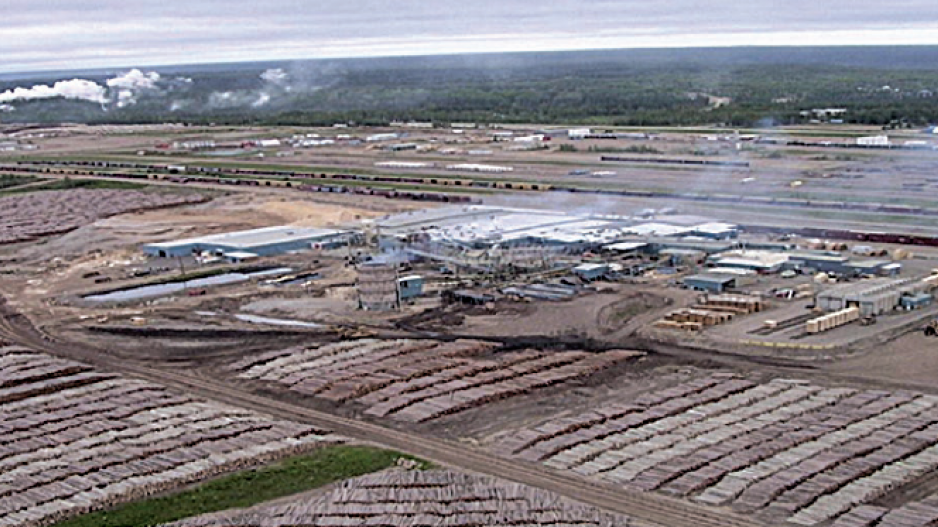In 2008, two years after Fort Nelson was named Forest Capital of B.C. by the Association of BC Forest Professionals, Canfor Corp. (TSX:CFP) closed its Tackama plywood and PolarBoard oriented strand board mills.
The closures came on the heels of the closure of the Tackama sawmill in 2005, which brought Fort Nelson’s forestry industry to a virtual standstill. The closures put about 500 mill workers and 100 loggers out of work, according to the Northern Rockies Regional Municipality (NRRM).
It wasn’t the mountain pine beetle that closed the mills – pine was never the primary source of wood in northeastern B.C.’s boreal forest in any case – but a downturn in the U.S. housing market.
But now that the market south of the border is in recovery, the NRRM says there is a business case for restarting sawmill operations in Fort Nelson.
“We operated at a very high level of production here for years,” said NRRM community development officer Mike Gilbert. “We have the trees, we have the sustainable cut. We have everything you need to support a healthy operation.”
Unlike the B.C. Interior, which is facing a shrinking wood basket, the Fort Nelson Forest District has an abundance of timber, Gilbert said.
Due to the mountain pine beetle outbreak, the annual allowable cut for the Interior is projected to drop from roughly 60 million cubic metres per year to about 42 million cubic metres per year by 2020. That’s below what the current mix of sawmills for the Interior currently processes, so more sawmill closures are expected in the coming years.
But because there has been virtually no logging in the northeast corner of the province for more than five years, the Fort Nelson Forest District now has a surplus of harvestable timber.
The region’s annual allowable cut is 1.62 million cubic metres. Since it’s been virtually untouched for more than five years, there is now an accumulated undercut of 6.3 million cubic metres, according to a forestry investment overview drafted by the NRRM.
“The undercut alone is the equivalent of what the Canfor operation would have consumed in five years,” Gilbert said. “So if you only consumed the undercut, that would give you five years of operation before you got into the annual allowable cut.”
Canfor Corp. is the major tree farm licence holder in the region. It owns two licences that were attached to the mills it operated. To date, the municipality hasn’t had much luck getting a commitment from the corporation to either restart mills or sell its licence to a company that will.
Nor has the municipality had much luck getting the provincial government to take up its cause.
“We’ve had very good co-operation with the local forest ministry, but at higher levels, I think the ministry has been a little less than enthusiastic,” Gilbert said. “We would like them to pitch in and help give our resource profile – marketing assistance and so on.”
A tree farm licence gives a company the right to cut trees on Crown land, but there is no obligation to exercise those cutting rights, according to the B.C. Ministry of Forests. The trees can have value even if they are not logged, said independent forestry consultant Bill Bourgeois.
“Most forest companies consider their licences as an asset and therefore they use that to go to the bank as fibre security to ask for loans,” he said. “They also can sell it.”
Whether Canfor ever plans to restart mills, sell its licences or sit on them is unclear. Canfor did not respond to a request for an interview.
Fort Nelson’s boreal forest has a mix of timber that includes pine, spruce and aspen. The spruce can be used for making dimensional lumber. Aspen has been derisively called a “weed” tree and is considered to be of little value. However, it can be used to make wood products such as oriented strand board.
Bourgeois said it would be hard to make a case for a new stand-alone dimensional lumber mill in the Fort Nelson area, unless it had some kind of value-added manufacturing or processing attached to it.
A number of forestry companies have developed bioenergy projects attached to sawmills to wring more value out of wood waste. But doing the same would not be viable in Fort Nelson, Bourgeois said.
There are other products that can be made from wood waste that have higher values, however, such as lignin and industrial sugars, which can be made into biofuel or biodegradable plastics.
“What Fort Nelson needs to do is create a forest sector that focuses on these higher-value products,” Bourgeois said. “I don’t think the economics is going to be suitable if all you’re going to do is cut them into two-by-fours, because if that was economically viable Canfor would still be doing it.” •




